Eye International Conference 2025

I was very fortunate to have the opportunity to represent the BFI National Archive at this year’s Eye International Conference 2025. The conference was held at the Eye Film Museum in Amsterdam in an impressive ‘Star Trek Voyager’ style building situated on the North Bank of Amsterdam’s Waterfront.
This was the 10th Eye International Conference and was presented under the topic ‘The Colour Fantastic Revisited: Across Global Histories, Theories, Aesthetics, and Archives’. It was organised by the University of Amsterdam and the University of Utrecht, in collaboration with Colour in Film (Colour Group GB & HTW Berlin).
There were many interesting and informative presentations from university scholars and professors, independent researchers, artists and conservation technicians. One section of the programme explored Race, Colour and Blackness in the Moving Image. The panel brought together discussions of colour in the works of moving image artists from across the African diaspora; Edward Owens, John Akomfrah, Crystal Z Campbell, and Steve McQueen.
Sarah Street, of the University of Bristol, presented a highly interesting paper around the works of the Ghanaian-born British artisit, John Akomfrah. It focused on how Akomfrah’s use of accented chromatic design became a central means of aesthetic expression and how it was used to explore issues of race, politics and Black British identities. This was particularly evident in his later film Nine Muses (2010) and multi-layered exhibition Listening All Night to the Rain (2024).
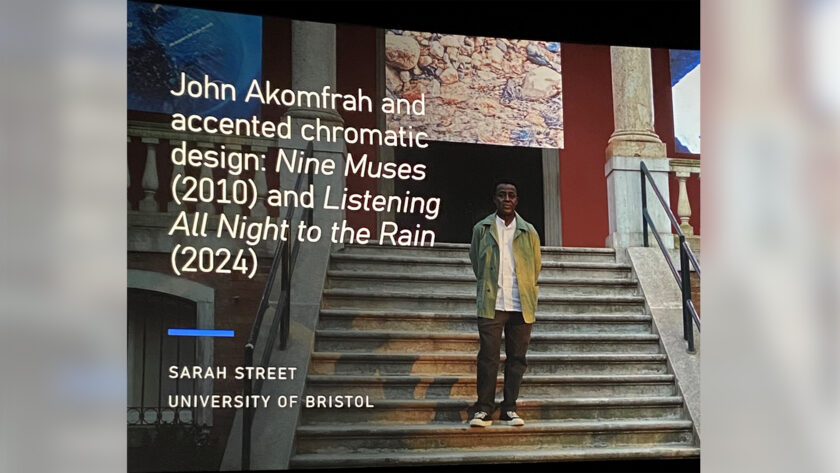
Bin Li, nitrate film specialist at Haghefilm, presented on the difficulty and limitations of using the Desmet Method to recreate historical tinting and toning in today’s ever-shrinking photochemical film laboratory. Modern film restorations of tinted and toned film often use the Desmet colour method to replicate the tinted and toned effect.
This also included a recent development which replaced the formerly used fine Grain Duplicating Panchromatic Negative Film stock with a digital separation film stock, which is designed for producing archival separations from colour digital masters. This discovery has provided successful results with slightly higher contrast as pictured in the tests below.
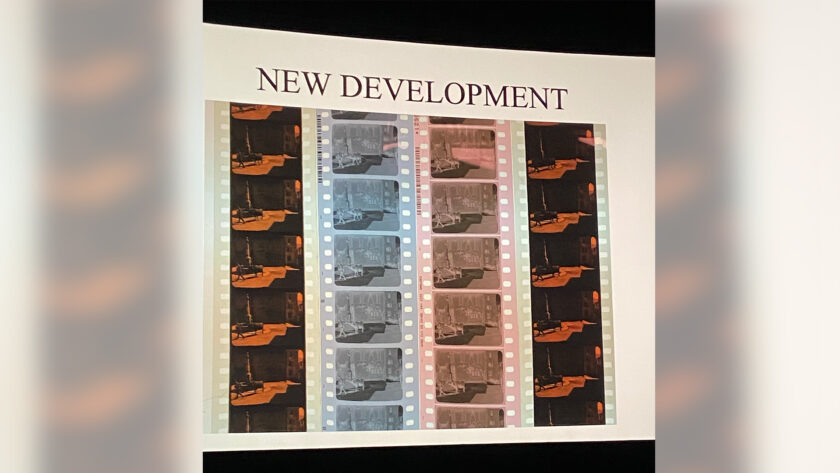
The previously used stock is the blue strip (with the print on the left) and the stock now being used is the pink strip (with the print on the right). The new development in stock can also be used to print from a digital source. It is fantastic to see this historical method, that began in the 1960s, is still evolving and developing today. More information about tinting and toning and the Desmet Method can be found here, which is a copy of a recent publication by Luisa Malzoni from Cinemateca Brasileira.
Luisa presented her research at the conference and her book documents the experiences of technicians and researchers restoring tinted and toned films at the Cinemateca, from 2008 to 2024. The book not only serves as a technical handbook for professionals but also as an important historical record of the restoration work that was achieved.
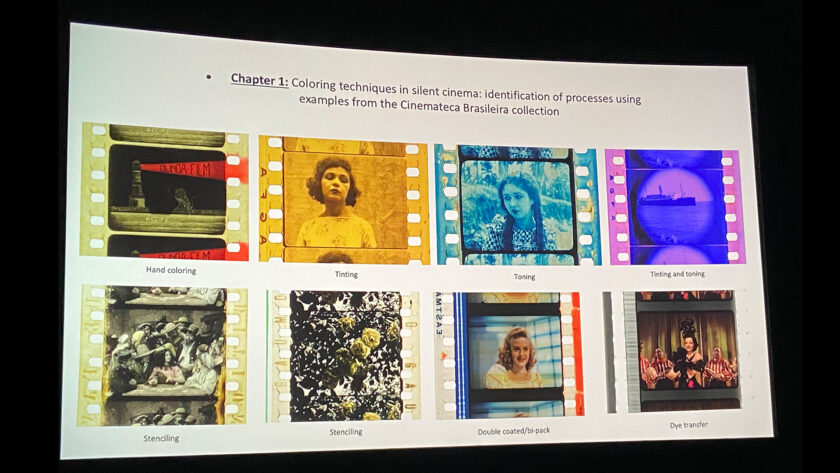
Caroline Figueroa Fuentes, from the Staatlichen Museen Zu, Berlin shared details of their study exploring the impact of essential oils on the colour integrity of motion picture films. It was suggested that with their antimicrobial and antifungal properties, they make a promising alternative for film cleaning and would offer a safer and more environmentally friendly option to chemical solvents.
Changes in colour parameters were quantified using the CIELAB colour system, with the results indicating minimal variations. However more research needs to be done to establish the long-term effects, something I am hoping we may be able to facilitate once the Moving Image Conservation Research Lab is installed.
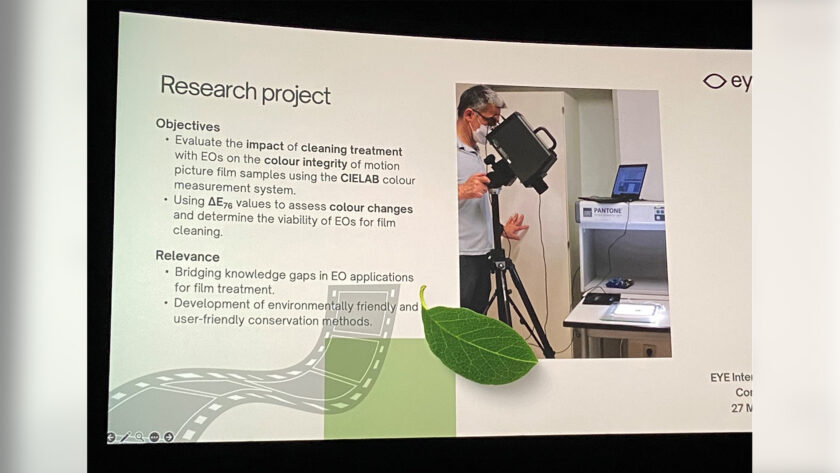
The conference ended with a presentation titled: “It’s not easy seeing green”: Colour Blindness Advocacy in the Study of Film Colour. Michael Marlatt, a Freelance Archival Accessibility Consultant, gave a presentation that questioned how colour blindness currently impacts the archivist and offered accessibility strategies on the inclusion of people who are colour blind within the archive. It was really encouraging to witness this presentation and to learn of the work that is taking place to promote inclusivity in the audiovisual sector.
– Kelly Hyams, Preservation Manager
BFI National Archive turns 90
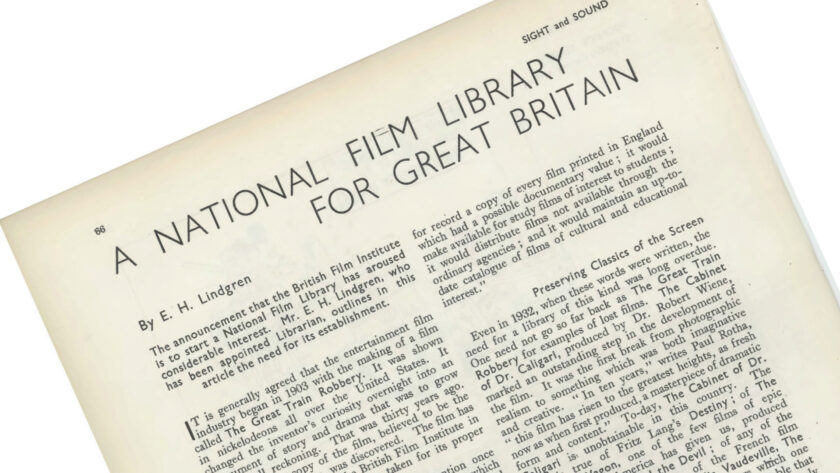
On 9 July 1935, the National Film Library – now the BFI National Archive – launched with a public call-out for donations.
Supporting press activity included a three-page article in Sight and Sound by trailblazing archivist Ernest Lindgren, which has been republished in full and online by the magazine to mark the Archive’s 90th anniversary.
Sight and Sound have also published – in their Summer 2025 edition – a new article by Pamela Hutchinson, exploring the Archive’s first ten years (as reported in the magazine) and how its work was impacted by the Second World War.
Keep your eyes peeled for more content exploring the BFI National Archive’s rich past, including Object of the Week articles celebrating historic pieces of conservation kit and video essays exploring landmark decades in the Archive’s history.
– Alex Prideaux, Marketing and Events Manager (Our Screen Heritage)
The Inside the Archive blog is supported by the BFI Screen Heritage Fund, awarding National Lottery funding.
